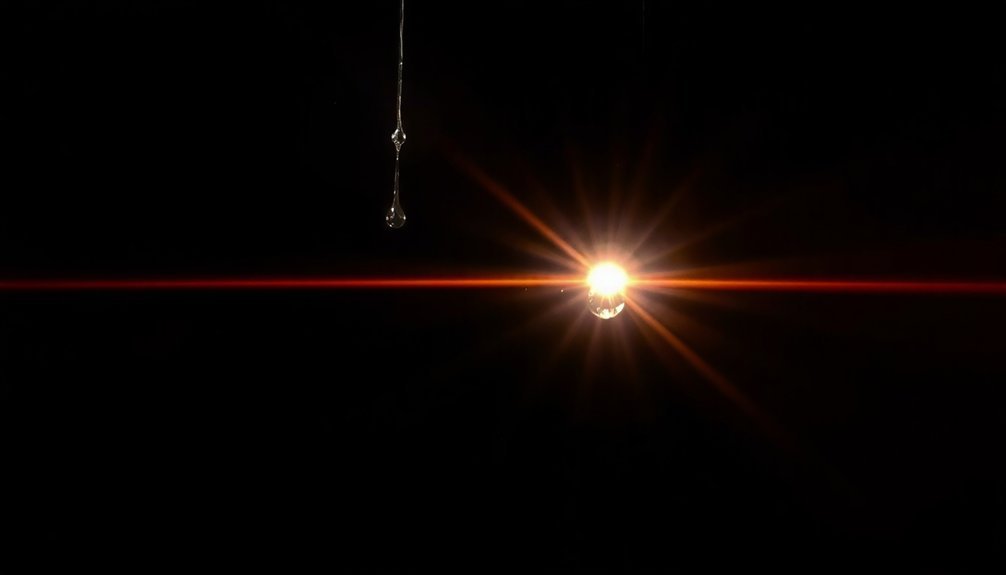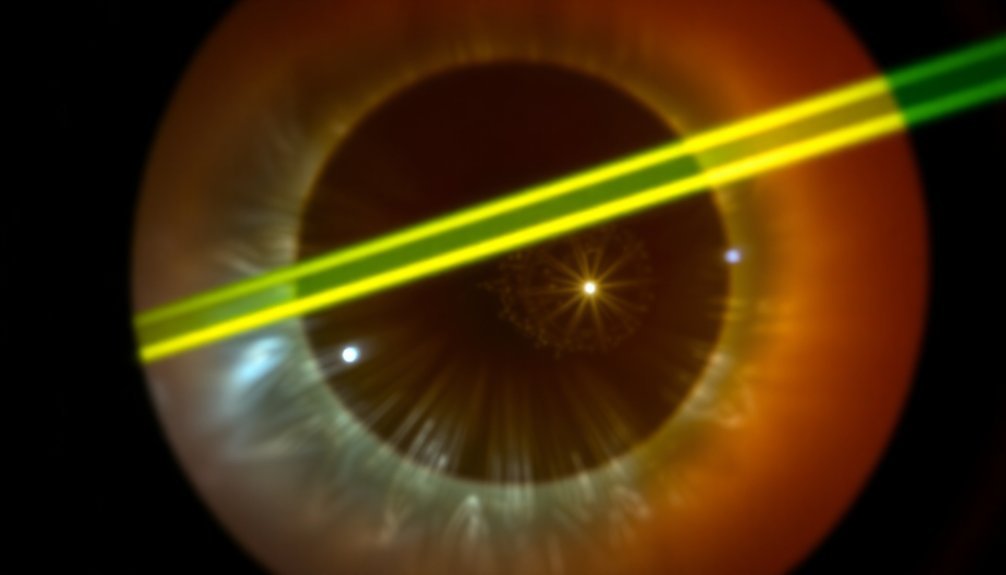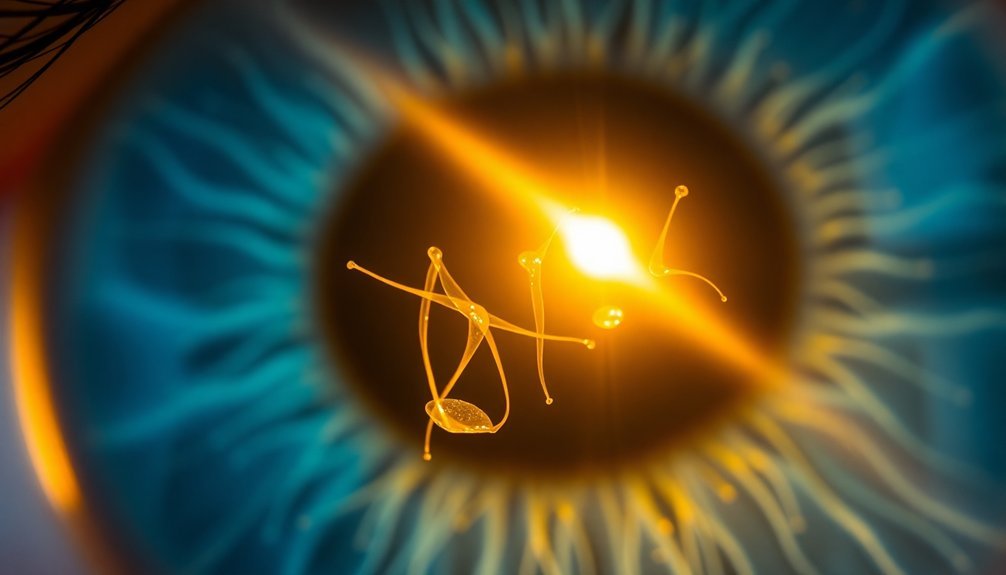Photonic treatment dissolves your eye floaters by using YAG laser technology to break down the debris floating in your eye's vitreous gel. The laser delivers concentrated pulses of light energy that vaporize the collagen strands causing those annoying spots and threads in your vision. You'll typically need 2-3 sessions, each lasting 20-60 minutes, to achieve the best results. Clinical studies show this safe, non-invasive procedure can reduce floater mass by 60-90% and improve symptoms in over half of patients. Understanding how this advanced treatment works can help you make an informed decision about managing your eye floaters.
Understanding Eye Floaters

Tiny specks, threads, and cobwebs drifting across your vision are telltale signs of eye floaters, a common condition that affects millions of people worldwide. These moving shapes occur when the vitreous gel in your eye begins to shrink and clump together, casting shadows on your retina. Looking at a blank wall often makes these floaters more noticeable.
You're more likely to develop floaters if you're over 50, as aging naturally causes changes in your eye's vitreous humor. If you're nearsighted, you may experience floaters at a younger age due to your eye's shape.
Other risk factors include diabetes, previous eye surgery, or inflammatory conditions like uveitis.
While most floaters are harmless and painless, they can be disruptive, especially when you're looking at bright backgrounds. You'll need a dilated eye exam to determine if your floaters are benign or indicate a more serious condition.
If you suddenly notice more floaters, accompanied by light flashes or peripheral vision loss, don't wait – seek immediate medical attention. These symptoms could signal a retinal tear or detachment, which requires urgent treatment to prevent vision loss.
Photonic Treatment Science Explained
Through recent advances in ophthalmology, photonic treatment has emerged as a promising solution for troublesome eye floaters. When you undergo this treatment, a YAG laser delivers nanosecond pulses of concentrated light energy to break down the collagen strands causing your floaters. The laser's cone-shaped energy profile focuses precisely on these strands, converting them into gas or vaporizing them completely. This treatment is particularly beneficial for patients experiencing posterior vitreous detachment, which often causes a sudden increase in floater visibility.
| Treatment Aspect | Process | Patient Experience |
|---|---|---|
| Duration | 20-60 minutes | Single session |
| Anesthesia | Eye drops | Minimal discomfort |
| Immediate Effect | Gas bubble formation | Temporary vision changes |
| Recovery | Quick | Minor redness possible |
| Results | Floater reduction | Multiple sessions may be needed |
You'll typically need 2-3 sessions for ideal results. During treatment, the laser safely passes through your cornea and lens while targeting specific points in the vitreous. Recent developments include nanoparticle-based therapies that create nanobubbles to mechanically break down floater aggregates. Clinical trials have shown promising results, with 54% of patients reporting improvement without significant side effects. While the procedure carries some risks if not performed correctly, ongoing research continues to enhance its safety and effectiveness.
Treatment Success and Safety

Clinical data shows compelling success rates for photonic eye floater treatments, with 54% of patients experiencing notable symptom improvements after YAG laser vitreolysis. You can expect a 60-90% reduction in floater mass, while vision improvement rates reach 80%.
For more severe cases, pars plana vitrectomy offers even higher success rates, with 93.8% of patients reporting complete symptom resolution. Most patients require 1.5 treatment sessions to achieve optimal results.
However, you'll need to carefully weigh these benefits against potential risks. YAG laser vitreolysis carries risks of increased floaters, cataracts, pressure changes, and possible retinal complications. The procedure's long-term effects aren't fully documented beyond 12 months.
Vitrectomy, while more definitive, comes with higher risks of retinal tears, infections, and cataract formation.
You're likely a good candidate for treatment if your floaters substantially impact daily activities like driving or reading, and they've persisted for over six months. Your doctor will need to confirm that your floaters are at least 2mm from both lens and retina for safe treatment.
It's crucial to try observation for two months before considering these interventions, as some floaters may improve naturally.
Recovery and Expected Results
After undergoing photonic eye floater treatment, you'll bounce back quickly, with most patients resuming normal activities immediately. You may experience mild discomfort, redness, or temporarily blurred vision, but these symptoms are typically short-lived. Common relief includes over-the-counter pain medication.
During recovery, you'll notice gas bubbles that look like new floaters, but don't worry – they'll dissolve within days.
Most patients see significant improvement in their floater symptoms, with many achieving complete resolution. Your contrast sensitivity and overall vision quality will improve as the gas bubbles are absorbed into the vitreous.
While the full recovery process takes a few weeks, you'll notice gradual improvement as your floaters decrease.
It's important to understand that not all floaters can be treated – about 80% are suitable for this procedure. You might need additional sessions, typically scheduled four weeks apart, to achieve the best results.
While rare, complications like cataracts or retinal tears can occur, so you'll need follow-up assessments to monitor your progress.
Long-term studies show that patients maintain their improved vision and quality of life, though the treatment may not eliminate every single floater.
Choosing Your Treatment Path

Selecting the right treatment for your eye floaters requires careful consideration of multiple factors. You'll need to evaluate the severity of your symptoms, particularly how they affect daily activities like driving and reading.
If your floaters have persisted for more than two months without improvement and markedly impact your quality of life, you're likely a candidate for treatment.
Two main options are available: YAG laser vitreolysis and vitrectomy surgery. The laser treatment may be your best choice if your floaters are positioned at least 2mm from both the lens and retina. You'll typically need 2-3 sessions, with each procedure lasting 10-60 minutes.
While the YAG laser shows a 54% improvement rate, you should know that some doctors prefer vitrectomy for persistent cases.
If you're considering treatment, you'll need to meet specific criteria. Your doctor will verify that your floaters aren't caused by other conditions and that any posterior vitreous detachment has stabilized.
The location of your floaters is vital – they must be within the safe treatment zone for best results and minimal risk.
Frequently Asked Questions
Can I Drive Myself Home After Photonic Treatment for Floaters?
You shouldn't drive yourself home after the treatment. Your vision will be temporarily blurred from dilating drops and contact lens gel. Instead, arrange for someone to drive you home for safety.
Will Insurance Cover Multiple Photonic Treatment Sessions if Needed?
Insurance typically won't cover multiple photonic treatments for floaters. You'll likely need to pay out-of-pocket, with additional sessions costing around $450 per eye after your initial treatment package is complete.
How Soon After Cataract Surgery Can I Undergo Photonic Floater Treatment?
You'll typically need to wait 3-6 months after cataract surgery before starting photonic floater treatment. This allows your eye to heal fully and helps your doctor determine if floaters will resolve naturally.
Does Eye Color Affect the Success Rate of Photonic Treatment?
Based on available research, your eye color doesn't affect the success rate of photonic floater treatment. The treatment's effectiveness depends more on the floater's location, density, and your overall eye health.
Can Photonic Treatment Address Floaters Caused by Diabetes or Other Medical Conditions?
You'll need different treatments for medically-caused floaters. While photonic therapy works for common floaters, diabetes-related ones typically require specific procedures like photocoagulation or focal laser treatment to address underlying health issues first.
In Summary
You'll find photonic treatment offers a promising solution for those troublesome eye floaters that affect your daily life. While it's not guaranteed to work for everyone, the laser-based therapy provides a non-invasive option with minimal recovery time. Consider discussing this treatment with your eye doctor to determine if you're a good candidate, weighing the benefits against traditional methods before making your choice.





Leave a Reply